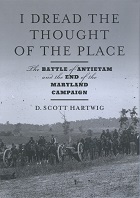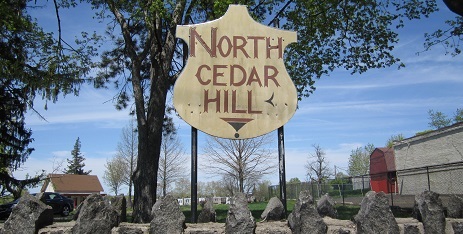| Home |

|
William
Henry Miner |
William Henry Miner was born on March 30, 1837 in Mauch Chunk, Carbon County, PA, the son of Elias and Mary (Cook) Miner. Possibly named for War of 1812 hero, congressman and future United States President William Henry Harrison, he was a veteran of the Civil War, and was twice married.
After attending public schools at Mauch Chunk, said the Carbon Advocate, he joined his father's iron moulding business and worked there until the outbreak of the Civil War. As an adult, he stood five feet, four inches in height, and weighed 120 lbs. He had a light complexion, with blue eyes and light hair.
William married his first wife Mary Jane Leidy (1838-1862). They resided at Maria Furnace in Mauch Chunk, but it's not known whether they children. The couple was not wedded for long before war and heartbreak intervened.
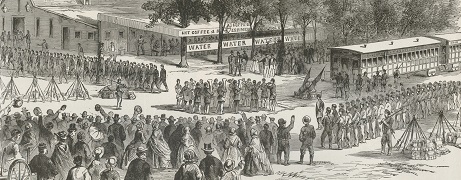 |
Federal soldiers in Philadelphia on their way to Union Army service Famous Leaders and Battle Scenes of the Civil War |
After the Civil War erupted, on Aug. 9, 1862, William and his brother-in-law Franklin Charles Wintermute joined the U.S. Army and were assigned together to the 132nd Pennsylvania Volunteer Infantry, Company F. During William's term in the army, he suffered a hernia for reasons not yet known. He also was recorded as having "intervals of insanity," quite likely having learned that his wife's health was in danger. Regimental surgeons gave his illness a name -- "monomania" -- which in layman's words meant "a single pathological obsession" -- again most likely fears about his dying bride.

~ Heroism at Antietam's Sunken Road ~
The 132nd Pennsylvania quickly made a mark of distinction at the Battle of Antietam on Sept. 17, 1862, where 22,726 men on both sides were killed, wounded or missing. It was the single bloodiest day on American soil, ever. In an astonishing twist, William and his brother-in-law were among five members of the extended Miner family to be present that day. At the Bloody Lane/Sunken Road, their regiment fought alongside two others from two other states, including the 8th Ohio Infantry (with William "Henry" Alderman) and the 7th West Virginia Infantry (including James Eyster Murdock Sr.).
Writing in Landscape Turned Red, author Stephen W. Sears says that at the sunken lane, "Brigaded with the veterans was the new 132nd Pennsylvania, another of Governor Curtin's nine-month regiments, and the rookies were visibly apprehensive. 'An occasional shell whizzed by or over, reminding us that we were rapidly approaching the "debatable ground," one of them wrote. 'The compressed lip and set teeth showed that nerve and resolution had been summoned to the discharge of duty. A few temporarily fell out, unable to endure the nervous strain, which was simply awful..."
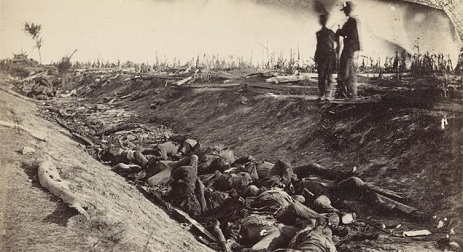 |
| Above, among the thousands of dead in Antietam's Bloody Lane -- and below, the 132nd Pennsylvania monument at the site today - Library of Congress |
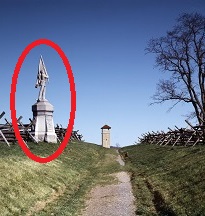 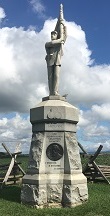 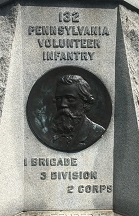 |
|
Hartwig's book Johns Hopkins University Press |
In his book I Dread the Thought of That Place, D. Scott Hartwig says that the fighting at the sunken road was a “lethal slugfest.” The 132nd Pennsylvania began to pour heavy fire into parts of the 6th Alabama and 2nd North Carolina. “Combined with the volleys from this front,” Hartwig writes, “this brought a withering crossfire against both of these exposed points on the Confederate line.” Some enemy soldiers tried to escape on foot but were mowed down as they ran.
Mears of the 132nd recalled that “some of the rebs in the pit tried to make their escape through the cornfield but there was but very few that would reach the top of the hill till they would get layed [out].” The tide finally turned in the favor of the 132nd.
As an example of the savage losses of the day at the sunken lane, the 14th North Carolina suffered 52 percent casualties and the 2nd North Carolina some 44 percent.
An army aid station was established on the local farm fields with dreadful sights and sounds. That evening, Hitchcock of the 132nd discovered that wounded troops were sprawled on the ground “so thickly that there was scarce room for the surgeons and their attendants to move about among them.” He witnessed many “piles of amputated arms, legs, and feet, thrown out with as little care as so many pieces of wood.”
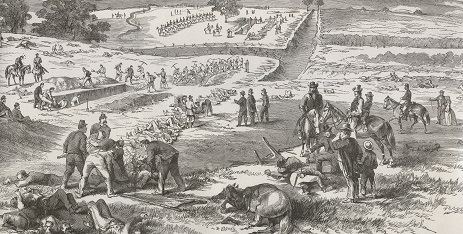 |
| Burial of the dead at Antietam - from a sketch by F.H. Schell |
~ Unspeakable Loss at Home ~
He was furloughed from Oct. 4, 1862 and came home to see Mary Jane. In what must have been wretched agony, after a stay of a month, he had to go back to the army on Nov. 3, 1862, with his wife lingering at death's door. Sadly, she died one day later, on Nov. 4, 1862. The remains were lowered into rest in the Mauch Chunk Cemetery, in William's absence. His sister Kate Wintermute is known to have attended the funeral. A brief obituary in the Mauch Chunk Gazette (Nov. 6, 1862) noted that her age was 24 years, three months and seven days.

Mauch Chunk
Gazette, Nov. 6, 1862
William's grief must have been un-imaginable.
During the remainder of his time in the army, William is not known to have seen action. He was discharged at Harrisburg on May 24, 1863 and returned home to Mauch Chunk.
William remained a widower for about a year and a half. His second wife was Philadelphia native Mary "Ellen" Derbyshire (1845-1918), daughter of English immigrant George Derbyshire. They were married in Philadelphia on March 16, 1864, by Rev. William Cathcart of the Baptist church. William was age 25 at the time, and Mary 18.
They had at least two sons, George Douglas Miner and Asa C. Miner.
Baby son George was born a year after the marriage, and was baptized on June 7, 1865, at the St. Paul's Methodist Church of Mauch Chunk. Among the witnesses was William's father Elias Miner as well as other family.
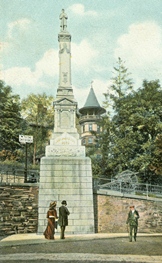 |
| Mauch Chunk's Civil War soldiers memorial |
After the war, William and his brother Charles Douglas "C.D." Miner pooled their savings and, with their father as superintendent "erected the Fort Allen foundry, which they have been running ever since," said the Carbon Advocate in August 1886. "This enterprise has grown rapidly during the past few years and is now recognized as the leading feature of our town -- giving employment to about thirty-five men who are kept busy all the year round."
A lengthy February 1879 profile of the foundry, in the Advocate, said that William and his brother Douglas were "two enterprising young men ... both practical moulders and skilled in the various details of the making of castings."
They took a risk in their investment, "with a capital so small that men with less courage would have shrunk from the undertaking even in promising times," said the Advocate. "William, the elder brother, lays aside for the nounce his foundry uniform, dons his 'Sunday-go-to-meetings,' patronizes the village barber who twirls the ends of his moustache, and hies away to the marts of trade; and he seldom, if ever, returns without a fresh supply of orders. As a consequence, during the recent panic, when hundreds of foundries run by corporations and stock companies, all over the country, have closed their doors for lack of remunerative orders, the Fort Allen Foundry has been kept steadily going, and at present writing is turning out plumbers' castings, pumps and fancy fountains, the castings for a half dozen different sewing and knitting machine companies, while from one to three men are kept constantly employed on miscellaneous home orders or job work. No piece of works leaves the foundry until it has been thoroughly inspected by one of the proprietors and found perfect."
William was the bookkeeper of the foundry business. His business trips included visits to New York City to develop relationships with potential customers and suppliers. When work was booming, he had to aggressively find and hire talented moulders with experience in fine iron castings. When a key engine he had ordered broke while being built, he hurried to New York to examine the damage. At other times, when their patterns wore out, the company was forced to temporarily lay off workers until new patterns could be fashioned.
The company found itself embroiled in a local political controversy in the spring of 1881. When a key piece of mail containing a check did not arrive, and knowing that a Democrat recently had been appointed postmaster of Weissport, the Miner brothers instructed their correspondents to send mail instead to nearby Lehighton. The company even employed a mail messenger to personally pick up the mail to assure proper arrival. Postmaster William H. Knecht responded that the letter in question had a key misspelling on the envelope and thus he returned it to the sender, rather than making sure it got into the right hands anyway.
The census of 1880 shows the Miners living in Weissport, Carbon County, where William was very active in the community. He was a member of the Knights of Honor and of the Bertolette Post of the Grand Army of the Republic of Lehighton. He also was engaged with civic matters involving the Borough of Weissport. In August 1879, as a member of the school board, he appointed a committee "to inspect the facilities for heating the school building, with discretionary powers to have the present apparatus repaired, or to purchase new ones, as he thinks best," said the Carbon Advocate. "Some necessary work needed to be done on the school grounds was also ordered." In June 1881, he was elected president of the school board, with Reuben Musselman as treasurer and D.B. Albright as secretary.
William ran for assessor of the borough in February 1880, but, "strange to say, met with crushing defeat," reported the Carbon Advocate. In the 1880s, he was a member of the iron moulders union in Lehighton (member no. 86812), with his name appearing in the Iron Moulders Journal.
In June 1882, as a high profile advertisement of the foundry's capabilities locally, possibly to enhance their volume of job work, William and his brother authorized an iron walkway to be installed along the front of their building, made in the plant. Business slowed the following year, with the Miner Bros. "working only two-thirds of the time," said the Advocate. "The foundry work is just as slow and stagnant as most all industrial works. The cause assigned is an over-production of commodities, and not Carlisle's election. How easily follow and ignorance subscribe such a condition of affairs to the latter."
When Mary Ellen's mother died in 1885, at the Miner home in Weissport, her remains were taken to Philadelphia for burial.
Personnel troubles at the foundry arose in the winter of 1886-1887, when the company rejected a lowball contract with W.S. Carr of New York City, for making steam valves, and had to lay off 25 employees as a result. At around that same time, the brothers placed a legal advertisement in the Advocate, stating they would not pay any debts agreed to by anyone else, and "not to trust any one on our account."
Unfortunately, the firm
dissolved in March 1887. The Carbon Advocate reported that brother D.C. would
take over the foundry work, saying "It is expected that the full force of
workmen will be put on at an early day." William and family then moved to Lower Slatington, Lehigh County, where he endeavored to
erect a new foundry and machine shop on Centre Street south of Chestnut. Slatington was a town built around the slate industry which produced thousands of blackboards and roof tiles over the years in the late 1800s and early 1900s.
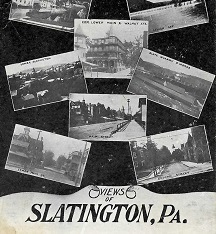
Views in Slatington
By 1889, their prospects for a new foundry apparently not having materialized, the Miners relocated to Philadelphia. The Slatington News said in a June 1889 story that Mary Ellen "was visiting friends at Weissport for the last few weeks. She returned here on Wednesday and took final leave on Saturday for Philadelphia where she will join her husband and son and make her future home." Their address in 1896 was 2664 Howard Street.
William suffered physical ailments as he aged, and applied for an "invalid pension" given his status as a military veteran. He claimed he was "totally unable to earn a support by manual labor" due to swelling of his testicles of the right side as well as hemorrhoids, rheumatism and lumbago. As the years went on, by 1905, he also complained of a hernia, heart disease, asthma and "physical weakness." He also lost two inches of height, and all of his teeth. The federal government awarded him a pension of $8.00 per month.
The 1900 census of Philadelphia shows the family dwelled on 2318 Hancock Street in Philadelphia, with William's occupation listed as "moulder." That year, 30-year-old son Asa, marked as married, but perhaps separated, made his home under their roof with his four children.
Suffering for two years from diabetes, William died in Philadelphia at the age of 69 on Feb. 7, 1907. Death occurred in the Miners' home at 2318 North Hancock Street, in the city's 19th Ward. He was laid to rest in the family's newly purchased plot of graves in North Cedar Hill Cemetery, in Lot 588, Section I. He left behind no property, savings or insurance except for one small Metropolitan Life Insurance Co. policy for $118.00 to benefit his wife.
Mary outlived her husband by more than a decade. She was awarded her husband's military pension and received a check for $8.00 each month. She resided with her son Asa in Philadelphia at 2831 Mascher Street.
Having suffered a stroke, and as she declined into senility, in early 1918, Mary was treated by Dr. James Van Buskirk, whose offices were at 2130 North Hancock Street in Philadelphia.
Mary died on April 17, 1918, at the age of 73, at home. She joined her husband in eternal repose in the North Cedar Hill Cemetery. Dr. J.L. Wildey handled the funeral arrangements, which included a polished casket, outside case, lady's dress and slippers, five limousines to the cemetery and four pair of pallbearers' gloves.
|
|
|
North Cedar Hill Cemetery, in Philadelphia's Frankford neighborhood |
~ Son George Douglas Miner ~
Son George Douglas Miner (1865-1931) was born on Feb. 5, 1865 in Mauch Chunk, Carbon County.
He moved to Philadelphia as a young man.
On Oct. 5, 1889, at age 24, George tied the marital cord with 17-year-old Mary Diana George (1871-1955), the daughter of Solomon and Dianna George. The wedding was held in Slatington, Lehigh County by a minister of the St. John's United Church of Christ. At the time, George lived in Philadelphia and worked as a moulder, and she was 17 and made her home in Walnutport, Northampton County, PA.
They together bore five children, of whom four are identified -- Marion W. Lueckel, Helen Kingsberry, Ira Bernard Miner and William Asa Miner. A set of twins -- a girl and a boy -- were stillborn on Nov. 21, 1892, with their tender remains lowered under the sod of Greenwood Cemetery..
Their address in 1894 was 2652 Howard Street, Philadelphia. In 1900, when the census was recorded, the Miners lived in Philadelphia at 2831 North Second Street, and George worked as an "iron moulder." Continuing to reside on Second Street, the family lived there as marked on the 1910 and 1920 censuses, with George maintaining his trade skill as a molder in an iron foundry (1910) and as inspector in a hardware house (1920). By 1931, they had moved to a different house on the same block, with an address of 2829 North Second.
Two of their infant sons are known to have been baptized in the Norris Square Methodist Episcopal Church in 1894 and 1907.
As he aged and retired, George began to show signs of senility. He was admitted to the Philadelphia Hospital for Mental Diseases. He died there of heart problems at the age of 66 on June 19, 1931. His remains were interred in Greenmount Cemetery.
Now widowed, Mary moved in with her married daughter Marion Lueckel at 439 Annsbury Street in Philadelphia. They are shown together in the 1940 federal census enumeration.
In the dead summer heat on the Fourth of July 1955, Mary suffered a heart attack and died at home the age of 83. She was placed by her husband's side at Greenmount.
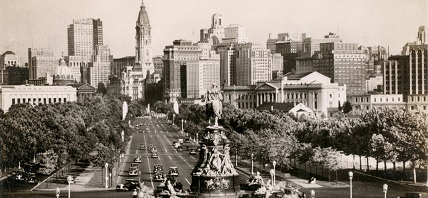 |
Philadelphia skyline and the mile-long Benjamin Franklin Parkway |
Daughter Marion W. Miner (1890-1958) was born on Sept. 2, 1890 in Philadelphia. As a girl of 12, she solved a series of puzzles in the Philadelphia Inquirer -- involving hidden names, beheaded words and pictures -- and won a prize of one dollar, with her name printed in the June 29, 1902 edition of the newspaper. Her future husband appears to have shared this interest as he won prizes for solving these puzzles in the late 1910s. Circa 1910, when she was age 19 and still single, Marion was employed as a stenographer in a law office in Philadelphia, and in 1920 worked as a stenographer in an elevator manufacturing company, also in Philadelphia. At the age of 32, in 1922, Marion was joined in holy wedlock with 37-year-old Frank Lueckel (1885-1951), son of Harry and Louise (Hollenberg) Lueckel. The couple did not reproduce. Frank was of medium height and build, with light colored hair and blue eyes. Prior to marriage, George lived at 4048 North Franklin in Philadelphia and worked as head shipper for Hires Turner Glass Company, manufacturers and importers of plate glass, mirrors and window glass. For years, they dwelled in Philadelphia at 439 West Annsbury Street and were members of Alpha Baptist Church. Frank earned a living as a card stamper for the textile firm of Glendon T. Nicholas, and Marion was a stenographer for an elevator parts business. At the age of 66, Frank suffered a massive heart attack and died in Metropolitan Hospital. His remains were placed into repose in Greenmount Cemetery in Philadelphia. Marion survived him by seven years. For the last six of those years, she suffered from a lingering infection of her skin, known as "necrotic dermatosis," causing it to rot and which eventually became life threatening. Her illness became toxic and at the age of 67, she died on July 15, 1958. Burial was in Greenmount Cemetery, with a death notice appearing in the Inquirer.
Daughter Helen Miner (1891-1958) was born in October (or Nov. 24), 1891. Her occupation in 1910 was as a "lace minder" in a Philadelphia "lace mill." In 1915, when she was 24 years of age, she married 24-year-old Philadelphia native Andrew Kingsberry (1891-1973). He had blue-grey eyes and red hair, with a medium build and height. They produced these known offspring, Gordon Kingsberry, Helen M. Kingsberry and Marian M. Hewitt. During World War I, Andrew registered for the military draft. At that time, he lived at 2507 Howard Street in Philadelphia and earned a living as a traveling salesman for the Standard Horseshoe Company headquartered in Boston, a position which he held for decades. When the federal census was taken in 1920, and again in 1930, the Kingsberrys dwelled in Philadelphia at the address of 4827 North Lawrence Street. By 1940, Andrew accepted a position as a manufacturer's agent for a steel company. They were affiliated with the Alpha Baptist Church. Suffering from heart and blood vessel disease, Helen died at home at the age of 61 on April 17, 1958. Her remains were interred in North Cedar Hill Cemetery. Andrew lived for another 15 years after her death and moved to 6023 North Third Street. He passed away on April 9, 1973. A death notice was published in the Philadelphia Inqurier.
-
Grandson Gordon Kingsberry (1916-1983) was born in about 1916 in Philadelphia. At the age of 24, single, in 1940, he lived at home and worked as a salesman for a sewing machine firm. When World War II broke out, he joined the U.S. Army as an intelligence agent and was educated at the Counter-Intelligence Training School in Baltimore. One of his first assignments was to interrogate ships' crews and refugees who arrived at the Port of Philadelphia. "The military information was used in the invasion of Italy and the highly effective air raid on Nuremberg," reported the Philadelphia Daily News. "The Army then send Kingsberry to the West coast and to Hawaii, where he questioned Japanese people to obtain military information and study Japanese organizations. This information aided the invasion of Okinawa, where he landed with a special detachment of 30 men." After the war's end, Gordon returned to Philadelphia and studied pre-law at Temple University. He joined First Pennsylvania Banking & Trust Company as a sales agent in 1948 and became a member of the American Banking Institute. He married Lois Smith ( ? -2018), and they produced five children -- Lois Brunet, Sandra Kingsberry, Paul Kingsberry, Alan Kingsberry and Donald Kingsberry. The Kingsberrys made their home in Penn Valley, Montgomery County. Gordon rose to become national vice president of the bank in March 1969 and retired from this position in 1981. Active in the community, Gordon spent his free time as treasurer of the Friendly Sons of St. Patrick and the Pennsylvania Ballet. He also belonged to the Musical Fund Society, Scotch Irish Society of the United States and the Union League. He enjoyed theatre and was a member of the Whitemarsh Curtain Callers. Following retirement, Gordon and Lois moved to Yarmouthport on Cape Cod, MA. He remained interested in the intelligence service and at one time was president of the Counter Intelligence Corps Association in Philadelphia and the National Counter Intelligence Corps. He occasionally published letters to the editor, focusing on foreign policy, in the Philadelphia Inquirer. In her own right, Lois was trained as a professional opera singer, organist and pianist. Said an obituary, she "performed with the Philadelphia Lyric Opera Company and The Philadelphia Grand Opera Company before they merged in 1975 to form the Opera Company of Philadelphia. She was a member of the American Guild of Musical Artists and the American Guild of Organists. Lois was a choir director and organist in multiple churches in the Philadelphia area and on Cape Cod. She also worked in the Development Office and the Office of the President of Bryn Mawr College for more than a decade and was a longstanding volunteer at the Philadelphia Museum of Art." Gordon passed away at the age of 67 on Aug. 23, 1983. He was pictured in a lengthy obituary in the Daily News. Lois outlived her husband by nearly 35 years. She was gathered in by the angel of death at age 92 on March 20, 2018.
Great-granddaughter Lois Kingsberry married (?) Brunet. She dwelled in Haverford, PA in 2018.
Great-granddaughter Sandra Kingsberry ( ? - ? ) wed (?) James ( ? - ? ). Her residence in 2018 was in Wilmington, DE.
Great-grandson Dr. Paul D. Kingsberry ( ? - ? )
Great-grandson Alan A. Kingsberry ( ? - ? ) made his home in Lafayette Hill.
Great-grandson Donald G. Kingsberry ( ? - ? ) settled in New Hampshire.
-
Granddaughter Helen M. Kingsberry (1921-2006) was born in about 1921 in Philadelphia. She was employed in 1940 as a clerk for an insurance company in Philadelphia. She married C. Edgar Stevens ( ? - ? ). The only son in this family was Mark Stevens. For a time they made a dwelling-place in Wyncote, PA and held a membership in the Olney Baptist Church. Helen died on Sept. 29, 2006. An obituary appeared in the Philadelphia Inquirer. Interment was in Forest Hills Cemetery.
Great-grandson Mark Stevens ( ? - ? ) is married to Royce. Their pair of sons are Scott A. Stevens and Jared M. Stevens.
-
Granddaughter Marian M. Kingsberry (1928-2006) was born in about 1928 in Philadelphia. She was wedded to (?) Hewitt. She is believed to have died on Jan. 13, 2006, with burial in Rosedale and Rosehill Cemetery in Linden, NJ.
Son Ira Bernard Miner (1894-1958) was born on Jan. 9, 1894 in Philadelphia. He received the rite of infant baptism on May 6, 1894 in the Norris Square Methodist Episcopal Church, officiated by Rev. Joseph B. Graff. Ira never married. He stood 5 feet, 9 inches tall in manhood and weighed 140 lbs. He earned a living during the World War I years as a roofer's helper. In 1920, at the age of 26, he lived at home, and was a sheet metal worker for a contractor in Philadelphia. His occupation in 1940 was as a general laborer. In 1942, when required to register for the military draft during World War II, he was residing next to or above George's Restaurant at 506 West Lehigh Avenue and had no job. He disclosed to the registrar that the restaurant would always know his whereabouts. He could well be the same "Ira Miner," living at Darien above Vine Street, who in April 1943 was found guilty of scavenging street litter and sentenced by Philadelphia Magistrate Keller H. Gilbert to 10 days' imprisonment in jail. In his 60s, living at 214 West Somerset Street in Philadelphia, he could only manage to generate income as a "scavenger." He was felled by pneumonia and died in Episcopal Hospital at the age of 64 on Feb. 17, 1958. Interment was in Greenmount Cemetery. His brother William A. Miner, of 4126 K Street, provided information for the death certificate.
Son William Asa Miner (1907-1981) was born on April Fool's Day 1907 in Philadelphia. Dr. J. Van Buskirk assisted in the birth. As an infant, on July 7, 1907, he received the rite of infant baptism in the Norris Square Methodist Episcopal Church, by the hand of Rev. Thomas W. Davis. He stood 5 feet, 8 inches tall in young manhood and weighed 223 lbs. William was a longtime bachelor, with an address circa 1940-1955 with his mother at 439 West Annsbury Street. His employment in 1940 was as a filling machine operator with American Preserve Company, and in 1955 he was a prison guard with the City of Philadelphia. At the age of 48, on Sept. 22, 1955, he was entered into marriage with 48-year-old Viola Pearle (Palmer) Egan ( ? -1981), daughter of George and Isabella (Smith) Palmer of Philadelphia. The wedding was held in the Arlington, VA, by the hand of Rev. Elmer Lucas of the Trinity Baptist Church. Viola was divorced from her first husband and brought a stepson into the union, James J. Egan Jr. The couple in 1958 made their home at 4126 K Street in Philadelphia. Their final residence was in Landsdowne, Delaware County, PA. Sadly, both William and Viola died on April 9, 1981. Burial was in Greenmount Cemetery, with obituaries appearing in the Philadelphia Inquirer.
- Step-grandson James J. Egan Jr. (1928-2006) was born on June 2, 1928 in Philadelphia. He served in the U.S. Army for two years and received the Army-Navy Production Award. He married Jessie R. Fontana ( ? - ? ). Their union endured for a remarkable 52 years' duration. They were the parents of Elaine Anderson. He is believed to have resided in 1981 in Colwyn, PA. For 35 years, he was employed by the Philadelphia Gas Works in a customer relations role. Said an obituary, James was "a member of the United States British Comrades. Jim enjoyed ballroom dancing, playing the piano and singing Irish songs with his buddy Dominick who was also his beloved brother-in-law." Death spirited him away on Jan. 19, 2006 as a resident of St. Francis Country House in Darby, PA. Burial of the remains was in Sunset Memorial Park, Philadelphia.
Step-great-granddaughter Elaine Egan wed Fred Anderson. They live in Powhatan, VA.
~ Son Asa C. Miner ~
Son Asa C. Miner (1869-1930) was born on June 20, 1869, in Mauch Chunk, Carbon County.
At the age of 19, he wed 18-year-old Maggie Roberts (1870- ? ), the daughter of Ellis Roberts of Slatington, Lehigh County, PA. Because they were underage, the groom and bride had to receive legal consent from their fathers. The ceremony was performed by Rev. John F. Scott on Sept. 8, 1888. At the time of marriage, Asa made his home in Slatington, Lehigh County, and marked his employment as "Founder" which may be short for "foundry."
They are believed to have had four children -- Raymond Miner, Norman Miner, George Miner and Bessie Rusk Frahner.
When the federal census was taken in 1900, Asa apparently had separated from Maggie and was living with the children under his parents' roof in Philadelphia. He and his father continued their longtime occupations as moulders.
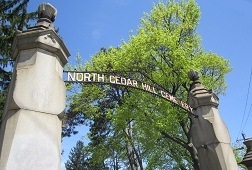 |
Philadelphia's North Cedar Hill Cemetery |
After the father's death in 1907, Asa's mother came to live in their home, at 2831 Mascher Street in Philadelphia. Neighbors Harry Ginn and Mary Thron both testified that they had "known him as a neighbor of good character."
In 1920, when the federal census was enumerated, Asa resided with married daughter Bessie Frahner and her family at the Mascher Street address. That year, Asa worked as a molder in a foundry.
Asa's home address in April 1930 was with the Frahners 3403 East Aldine Street. Age 60 at the time, he had no occupation, and likely was dying.
At the age of 61, suffering from chronic bronchitis, Asa passed away on Christmas Eve 1930. He was laid to rest in Philadelphia's North Cedar Hill Cemetery. No stone marks his grave today.
Maggie's whereabouts and final story are not yet known.
Son Raymond Miner (1888- ? ) was born in November 1888.
Son Norman D. Miner (1891-1960) was born on Aug. 9, 1891. He married Roberta ( ? - ? ). Their home was at 2750 Front Street in Philadelphia. Norman was employed over the years as an operator with Philadelphia Transportation Company, the primary public transit system in the city. Burdened with hypertension and hardening of the arteries, Norman died at the age of 68 on May 23, 1960. His remains were lowered into rest at the George Washington Memorial Park in Whitemarsh, PA.
Son George Miner (1893-1943) was born on Jan. 14, 1893 in Philadelphia. He married English immigrant Elizabeth Clapham (1894-1918), daughter of Henry and Annie (Witherill) Clapham of England. They made their home with Elizabeth's parents at 141 Lippincott Street in Philadelphia, and George earned a living as a carpenter. During the epidemic sweep of influenza in the United States in 1918, Elizabeth became infected and died of bronchial pneumonia, at the age of only 24, on Oct. 14, 1918. She was interred in North Cedar Hill Cemetery following funeral services held at her mother's residence. A short notice of her death was published in the Philadelphia Public Ledger. Later, George moved to a new address at 9222 German Street. Suffering from heart disease at the age of 50, George was admitted to Philadelphia General Hospital and died there on Feb. 26, 1943. Burial was in North Cedar Hill Cemetery, with his sister Bessie Frahner signing the official Pennsylvania death certificate.
Daughter Bessie Rusk Miner (1896-1948) was born on May 13, 1896 in Philadelphia. At the age of 21, in 1917, she wed 22-year-old Benjamin "Franklin" Rowen Frahner (1895-1962). They had at least three children, among them Elizabeth Hazell, William Frahner and Harry Frahner. Sadly, son William only lived to the age of 11 days in April 1923 due to collapsed lungs. Bessie was a nurse by training. In 1918, newly married, she helped provide medical care for her dying grandmother, Mary "Ellen" (Derbyshire) Miner. The Frahners' first home was with Bessie's parents at 2831 North Mascher Street. Later, they moved to 9227 Cambridge Street in Philadelphia. The federal censuses of 1920 and 1930 show that Frank was employed as a knitter in a hosiery mill. Bessie suffered from coronary occlusion and passed away at the age of 52 on May 19, 1948. Her remains were placed into rest with her parents at North Cedar Hill. The Philadelphia Inquirer printed a death notice. Franklin outlived her by 14 years and remained in their home. We are looking into whether he may have married again, to Henrietta Gordon (circa 1954) and Loretta Sullivan ( ? - ? ). He spent his final years residing at 9227 Cambridge Street. He died on the Fourth of July 1962, at the age of 67. Burial was in North Cedar Hill, with a death notice appearing in the Inquirer.
-
Granddaughter Elizabeth Frahner (1918-1960) was born on Nov. 29, 1918 in Philadelphia. She was joined in marriage with Willard D. Hazell ( ? - ? ). They are thought to have had a family. In 1960, their home was at 5133 Arendell Street in Philadelphia. Sadly, at the age of 41, and having endured hardening of her heart muscles, Elizabeth was stricken with a heart attack and died on July 25, 1960. Her remains were placed into rest in Forest Hills Cemetery near Philadelphia.
-
Grandson Harry Frahner (1921- ? ) was born in 1921 in Philadelphia.
|
Copyright © 2011-2015, 2017, 2024 Mark A. Miner |
